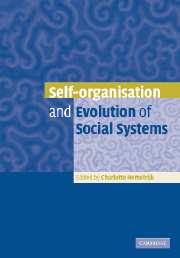Book contents
- Frontmatter
- Contents
- List of contributors
- Preface
- Introduction
- 1 From unicellular to multicellular organisation in the social amoeba Dictyostelium discoideum
- 2 Optimality of communication in self-organised social behaviour
- 3 The interplay of intracolonial genotypic variance and self-organisation of dominance hierarchies in honeybees
- 4 Traffic rules of fish schools: a review of agent-based approaches
- 5 A process-oriented approach to the social behaviour of primates
- 6 Order and noise in primate societies
- 7 Self-organisation in language
- 8 Dictatorship effect of majority rule in voting in hierarchical systems
- 9 Natural selection and complex systems: a complex interaction
- 10 Interlocking of self-organisation and evolution
- Index
- References
3 - The interplay of intracolonial genotypic variance and self-organisation of dominance hierarchies in honeybees
Published online by Cambridge University Press: 07 December 2009
- Frontmatter
- Contents
- List of contributors
- Preface
- Introduction
- 1 From unicellular to multicellular organisation in the social amoeba Dictyostelium discoideum
- 2 Optimality of communication in self-organised social behaviour
- 3 The interplay of intracolonial genotypic variance and self-organisation of dominance hierarchies in honeybees
- 4 Traffic rules of fish schools: a review of agent-based approaches
- 5 A process-oriented approach to the social behaviour of primates
- 6 Order and noise in primate societies
- 7 Self-organisation in language
- 8 Dictatorship effect of majority rule in voting in hierarchical systems
- 9 Natural selection and complex systems: a complex interaction
- 10 Interlocking of self-organisation and evolution
- Index
- References
Summary
Multiple mating in social insects
Multiple mating of females (polyandry) is a rare phenomenon in social hymenoptera (Strassmann, 2001). The adaptive value of single mating seems obvious: females should mate with as few males as possible to minimise predation risk during mating, the energy costs involved in mating and the chance of contracting a disease. Most importantly, polyandry nullifies the benefits of male haploidy for the inclusive fitness of the sterile workers in the colony. Multiple mating dramatically reduces the intracolonial relatedness (Boomsma and Ratnieks, 1996) and hence reduces the force of the arguments of kin selection theory (Hamilton 1964a, b), because the high intracolonial genotypic diversity creates an extreme potential for conflict among the nest members. Fourteen evolutionary rescue hypotheses have been identified to explain the potential benefits of polyandry in spite of the additional mating costs (Crozier and Fjerdingstad, 2001).
Although considerable effort has been expended to explain the evolution of polyandry, the consequences of polyandry for the organisation of the society have received less attention. The honeybees (Apis spp.) may be an exception in this regard. This is primarily due to a relatively large research community working on Apis because of its economic significance. The knowledge accumulated on the biology of Apis exceeds that of other social insects by far. The other rather fortunate property is the extreme degree of polyandry in the honeybee (Palmer and Oldroyd, 2000). Multiple mating in Apis can exceed 50 drones per queen (Moritz et al., 1995, Palmer and Oldroyd, 2001).
- Type
- Chapter
- Information
- Publisher: Cambridge University PressPrint publication year: 2005
References
- 2
- Cited by

